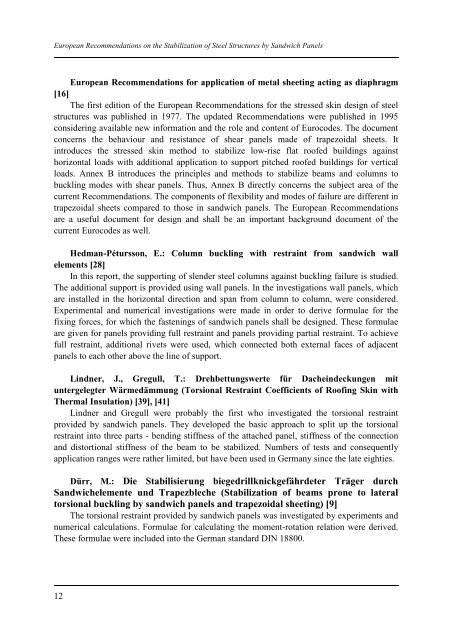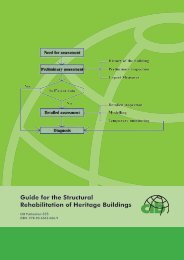European Recommendations on the Stabilization of Steel ... - Xs4all
European Recommendations on the Stabilization of Steel ... - Xs4all
European Recommendations on the Stabilization of Steel ... - Xs4all
- No tags were found...
You also want an ePaper? Increase the reach of your titles
YUMPU automatically turns print PDFs into web optimized ePapers that Google loves.
<str<strong>on</strong>g>European</str<strong>on</strong>g> <str<strong>on</strong>g>Recommendati<strong>on</strong>s</str<strong>on</strong>g> <strong>on</strong> <strong>the</strong> Stabilizati<strong>on</strong> <strong>of</strong> <strong>Steel</strong> Structures by Sandwich Panels<str<strong>on</strong>g>European</str<strong>on</strong>g> <str<strong>on</strong>g>Recommendati<strong>on</strong>s</str<strong>on</strong>g> for applicati<strong>on</strong> <strong>of</strong> metal sheeting acting as diaphragm[16]The first editi<strong>on</strong> <strong>of</strong> <strong>the</strong> <str<strong>on</strong>g>European</str<strong>on</strong>g> <str<strong>on</strong>g>Recommendati<strong>on</strong>s</str<strong>on</strong>g> for <strong>the</strong> stressed skin design <strong>of</strong> steelstructures was published in 1977. The updated <str<strong>on</strong>g>Recommendati<strong>on</strong>s</str<strong>on</strong>g> were published in 1995c<strong>on</strong>sidering available new informati<strong>on</strong> and <strong>the</strong> role and c<strong>on</strong>tent <strong>of</strong> Eurocodes. The documentc<strong>on</strong>cerns <strong>the</strong> behaviour and resistance <strong>of</strong> shear panels made <strong>of</strong> trapezoidal sheets. Itintroduces <strong>the</strong> stressed skin method to stabilize low-rise flat ro<strong>of</strong>ed buildings againsthoriz<strong>on</strong>tal loads with additi<strong>on</strong>al applicati<strong>on</strong> to support pitched ro<strong>of</strong>ed buildings for verticalloads. Annex B introduces <strong>the</strong> principles and methods to stabilize beams and columns tobuckling modes with shear panels. Thus, Annex B directly c<strong>on</strong>cerns <strong>the</strong> subject area <strong>of</strong> <strong>the</strong>current <str<strong>on</strong>g>Recommendati<strong>on</strong>s</str<strong>on</strong>g>. The comp<strong>on</strong>ents <strong>of</strong> flexibility and modes <strong>of</strong> failure are different intrapezoidal sheets compared to those in sandwich panels. The <str<strong>on</strong>g>European</str<strong>on</strong>g> <str<strong>on</strong>g>Recommendati<strong>on</strong>s</str<strong>on</strong>g>are a useful document for design and shall be an important background document <strong>of</strong> <strong>the</strong>current Eurocodes as well.Hedman-Péturss<strong>on</strong>, E.: Column buckling with restraint from sandwich wallelements [28]In this report, <strong>the</strong> supporting <strong>of</strong> slender steel columns against buckling failure is studied.The additi<strong>on</strong>al support is provided using wall panels. In <strong>the</strong> investigati<strong>on</strong>s wall panels, whichare installed in <strong>the</strong> horiz<strong>on</strong>tal directi<strong>on</strong> and span from column to column, were c<strong>on</strong>sidered.Experimental and numerical investigati<strong>on</strong>s were made in order to derive formulae for <strong>the</strong>fixing forces, for which <strong>the</strong> fastenings <strong>of</strong> sandwich panels shall be designed. These formulaeare given for panels providing full restraint and panels providing partial restraint. To achievefull restraint, additi<strong>on</strong>al rivets were used, which c<strong>on</strong>nected both external faces <strong>of</strong> adjacentpanels to each o<strong>the</strong>r above <strong>the</strong> line <strong>of</strong> support.Lindner, J., Gregull, T.: Drehbettungswerte für Dacheindeckungen mituntergelegter Wärmedämmung (Torsi<strong>on</strong>al Restraint Coefficients <strong>of</strong> Ro<strong>of</strong>ing Skin withThermal Insulati<strong>on</strong>) [39], [41]Lindner and Gregull were probably <strong>the</strong> first who investigated <strong>the</strong> torsi<strong>on</strong>al restraintprovided by sandwich panels. They developed <strong>the</strong> basic approach to split up <strong>the</strong> torsi<strong>on</strong>alrestraint into three parts - bending stiffness <strong>of</strong> <strong>the</strong> attached panel, stiffness <strong>of</strong> <strong>the</strong> c<strong>on</strong>necti<strong>on</strong>and distorti<strong>on</strong>al stiffness <strong>of</strong> <strong>the</strong> beam to be stabilized. Numbers <strong>of</strong> tests and c<strong>on</strong>sequentlyapplicati<strong>on</strong> ranges were ra<strong>the</strong>r limited, but have been used in Germany since <strong>the</strong> late eighties.Dürr, M.: Die Stabilisierung biegedrillknickgefährdeter Träger durchSandwichelemente und Trapezbleche (Stabilizati<strong>on</strong> <strong>of</strong> beams pr<strong>on</strong>e to lateraltorsi<strong>on</strong>al buckling by sandwich panels and trapezoidal sheeting) [9]The torsi<strong>on</strong>al restraint provided by sandwich panels was investigated by experiments andnumerical calculati<strong>on</strong>s. Formulae for calculating <strong>the</strong> moment-rotati<strong>on</strong> relati<strong>on</strong> were derived.These formulae were included into <strong>the</strong> German standard DIN 18800.12
















